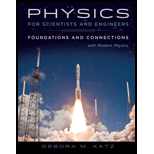
Two bumper cars at the county fair are sliding toward one another (Fig. P11.54). Initially, bumper car 1 is traveling to the east at 5.62 m/s, and bumper car 2 is traveling 60.0° south of west at 10.00 m/s. They collide and stick together, as the driver of one car reaches out and grabs hold of the other driver. The two bumper cars move off together after the collision, and friction is negligible between the cars and the ground.
- a. If the masses of bumper cars 1 and 2 are 596 kg and 625 kg respectively, what is the velocity of the bumper cars immediately after the collision?
- b. What is the kinetic energy lost in the collision?
- c. Compare your answers to part (b) from this and Problem 54. Is one answer larger than the other? Discuss and explain any differences you find.
(a)
The velocity of the bumper cars after collision.
Answer to Problem 55PQ
The velocity of the bumper cars after collision is
Explanation of Solution
Consider positive
According to law of conservation of momentum initial momentum in x direction is equal to the final total momentum in x direction.
Rewrite equation (I) in terms of mass and velocity
Here,
Car 1 is moving towards east and car 2 moves towards south of the west. Since two cars are moving in opposite direction
Rearrange equation (II) to obtain an expression for
Similarly initial momentum in y direction is equal to the final momentum in y direction.
Similar to equation (III) final velocity in y direction can written in which the y component of velocity of car 1,
Hence, expression for final velocity in y direction is.
The magnitude of final velocity of car 2 is
The expression for direction of final velocity of car 2.
Conclusion:
Substitute,
Substitute,
Substitute, equation (VIII) and (IX) in (VI).
Substitute, equation (VIII) and (IX) in (VII).
Therefore, the velocity of the bumper cars after collision is
(b)
The kinetic energy lost in collision.
Answer to Problem 55PQ
The kinetic energy lost in collision is
Explanation of Solution
Write the expression for lost kinetic energy.
Conclusion:
Substitute,
Therefore, the kinetic energy lost in collision is
(c)
Compare the answers in part (b) of this and problem 54, and explain if there are any differences.
Answer to Problem 55PQ
The kinetic energy lost is greater in this problem, since collision is completely inelastic.
Explanation of Solution
Kinetic energy lost in previous problem is
In an elastic collision there is no loss in kinetic energy, and total energy is conserved. But in an inelastic collision, there will be a fractional loss in kinetic energy. An extreme case of inelastic collision is the one in which colliding objects stick together. In such situations kinetic energy loss will be maximum.
Conclusion:
Since two cars stick together after collision in this case kinetic energy loss will be greater as compared to problem 54.
Want to see more full solutions like this?
Chapter 11 Solutions
Webassign Printed Access Card For Katz's Physics For Scientists And Engineers: Foundations And Connections, 1st Edition, Single-term
- No chatgpt pls will upvote Iarrow_forwardHow would partial obstruction of an air intake port of an air-entrainment mask effect FiO2 and flow?arrow_forward14 Z In figure, a closed surface with q=b= 0.4m/ C = 0.6m if the left edge of the closed surface at position X=a, if E is non-uniform and is given by € = (3 + 2x²) ŷ N/C, calculate the (3+2x²) net electric flux leaving the closed surface.arrow_forward
- No chatgpt pls will upvotearrow_forwardsuggest a reason ultrasound cleaning is better than cleaning by hand?arrow_forwardCheckpoint 4 The figure shows four orientations of an electric di- pole in an external electric field. Rank the orienta- tions according to (a) the magnitude of the torque on the dipole and (b) the potential energy of the di- pole, greatest first. (1) (2) E (4)arrow_forward
- What is integrated science. What is fractional distillation What is simple distillationarrow_forward19:39 · C Chegg 1 69% ✓ The compound beam is fixed at Ę and supported by rollers at A and B. There are pins at C and D. Take F=1700 lb. (Figure 1) Figure 800 lb ||-5- F 600 lb بتا D E C BO 10 ft 5 ft 4 ft-—— 6 ft — 5 ft- Solved Part A The compound beam is fixed at E and... Hình ảnh có thể có bản quyền. Tìm hiểu thêm Problem A-12 % Chia sẻ kip 800 lb Truy cập ) D Lưu of C 600 lb |-sa+ 10ft 5ft 4ft6ft D E 5 ft- Trying Cheaa Những kết quả này có hữu ích không? There are pins at C and D To F-1200 Egue!) Chegg Solved The compound b... Có Không ☑ ||| Chegg 10 וחarrow_forwardNo chatgpt pls will upvotearrow_forward
 Physics for Scientists and Engineers: Foundations...PhysicsISBN:9781133939146Author:Katz, Debora M.Publisher:Cengage Learning
Physics for Scientists and Engineers: Foundations...PhysicsISBN:9781133939146Author:Katz, Debora M.Publisher:Cengage Learning Principles of Physics: A Calculus-Based TextPhysicsISBN:9781133104261Author:Raymond A. Serway, John W. JewettPublisher:Cengage Learning
Principles of Physics: A Calculus-Based TextPhysicsISBN:9781133104261Author:Raymond A. Serway, John W. JewettPublisher:Cengage Learning Physics for Scientists and Engineers with Modern ...PhysicsISBN:9781337553292Author:Raymond A. Serway, John W. JewettPublisher:Cengage Learning
Physics for Scientists and Engineers with Modern ...PhysicsISBN:9781337553292Author:Raymond A. Serway, John W. JewettPublisher:Cengage Learning University Physics Volume 1PhysicsISBN:9781938168277Author:William Moebs, Samuel J. Ling, Jeff SannyPublisher:OpenStax - Rice University
University Physics Volume 1PhysicsISBN:9781938168277Author:William Moebs, Samuel J. Ling, Jeff SannyPublisher:OpenStax - Rice University Classical Dynamics of Particles and SystemsPhysicsISBN:9780534408961Author:Stephen T. Thornton, Jerry B. MarionPublisher:Cengage Learning
Classical Dynamics of Particles and SystemsPhysicsISBN:9780534408961Author:Stephen T. Thornton, Jerry B. MarionPublisher:Cengage Learning Modern PhysicsPhysicsISBN:9781111794378Author:Raymond A. Serway, Clement J. Moses, Curt A. MoyerPublisher:Cengage Learning
Modern PhysicsPhysicsISBN:9781111794378Author:Raymond A. Serway, Clement J. Moses, Curt A. MoyerPublisher:Cengage Learning





